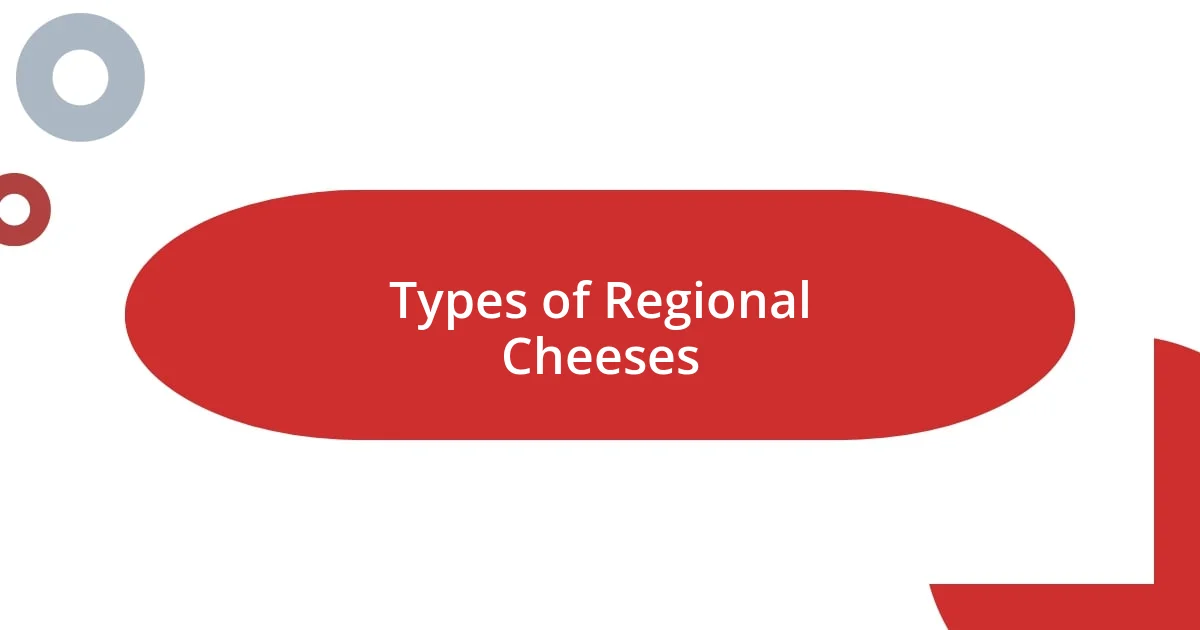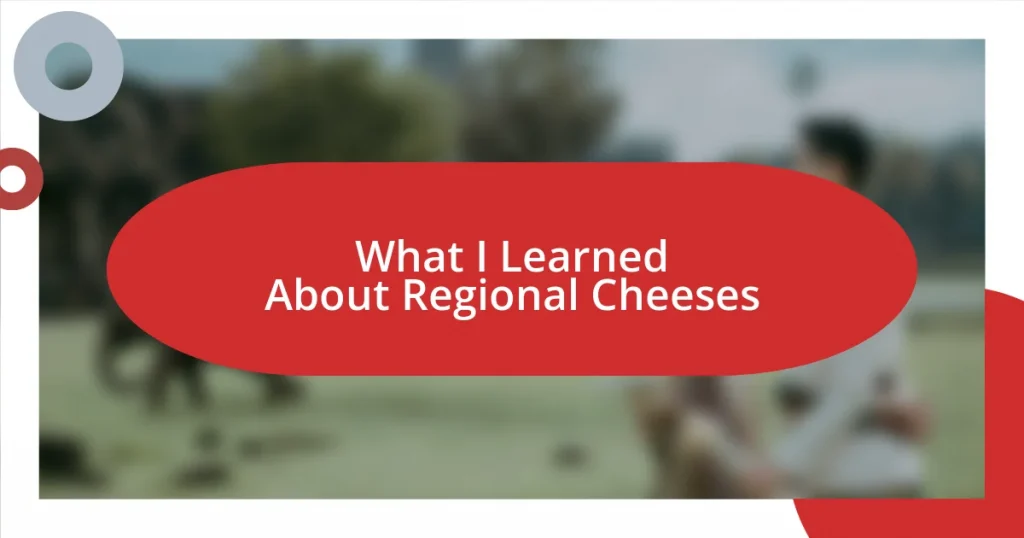Key takeaways:
- Regional cheeses encapsulate local culture, history, and artisanal craftsmanship, providing a unique connection to their origins.
- Tasting and pairing regional cheeses enhances flavor experiences, showcasing the right combinations of accompaniments and beverages.
- Cheese production techniques vary by region, influencing flavor and texture significantly, with factors like milk source, aging, and traditional methods playing crucial roles.

Introduction to Regional Cheeses
When I first delved into the world of regional cheeses, I was struck by how each one tells a story, reflecting its unique environment and culture. Have you ever tasted a cheese that transported you to a specific place? I remember sitting in a quaint café in France, savoring a creamy Camembert while surrounded by the gentle hum of a bustling town square.
Exploring regional cheeses is like embarking on a flavorful journey. Each cheese variety offers a glimpse into the traditions and practices of local artisans, showcasing the importance of climate, grazing patterns, and even the milk source. For instance, I once tried a sharp, tangy goat cheese from a small farm in California, and it was incredible to learn that its distinct flavor was influenced by the wild herbs that the goats grazed on.
I find it fascinating how these cheeses can spark memories and emotions tied to place. Just thinking about the nutty flavors of aged Parmigiano-Reggiano takes me back to cozy evenings spent with friends over pasta dishes in an Italian trattoria. Isn’t it amazing how something as simple as cheese can create those connections and deepen our appreciation for the culinary world?

Importance of Regional Cheeses
The importance of regional cheeses goes beyond mere taste; it encompasses the rich tapestry of culture, history, and community. I recall a trip to Italy, where local cheesemakers proudly shared their craftsmanship. It was evident that their passion and dedication were integral to the identity of the cheese they produced. This deep-rooted connection to place and people not only enriches the flavor but also nurtures a sense of belonging and pride among local producers.
- Cultural Heritage: Regional cheeses encapsulate the traditions and stories of their origins.
- Sense of Place: Each cheese reflects the specific environment, from the soil to the grazing patterns of the animals.
- Artisanal Craftsmanship: Local cheesemakers often use traditional methods passed down through generations.
- Community Support: Purchasing regional cheeses bolsters local economies and fosters community connections.
- Flavor Profiles: Distinct characteristics stem from local milk sources, soil, and climate, making every cheese unique.
Each bite of regional cheese is not just about satisfying a craving; it connects us to the land, the artisans, and the rich histories ingrained in every layer of flavor. It’s as though when I savor a locally made blue cheese, I’m tasting the craftsmanship and stories of the rural community that shaped it. That’s the beauty of regional cheeses—they offer a tangible link to a specific place, reminding us of the diverse flavors the world has to offer.

Types of Regional Cheeses
The world of regional cheeses is remarkably diverse and full of character. For instance, I remember discovering the creamy richness of a local Brie from Normandy on a trip there. It was like biting into a piece of history, as the cheese was crafted using traditional methods. The authority of the local farmers’ practices shone through in each bite, and I couldn’t help but feel a personal connection to those who poured their heart into making it.
Another fascinating type is the aged Gouda from the Netherlands. On my travels, a cheesemaker invited me to sample their aged varieties. The depth of flavor in the cheese was astonishing, with notes of caramel and toffee that lingered beautifully on my palate. Each slice felt like a tribute to the years of care and aging that had gone into its creation. It made me appreciate the time and dedication behind every wheel of cheese.
Regional cheeses also vary greatly in texture and appearance. Take, for example, the crumbly Feta from Greece, often infused with herbs, which reminds me of sun-drenched Mediterranean summers. Comparatively, there’s the soft and spreadable Valdeon from Spain, which boasts a rich blue flavor that can elevate any tapas experience. The unique characteristics of these cheeses don’t just tell a story; they invite you to partake in a cultural journey through flavors.
| Type of Cheese | Key Characteristics |
|---|---|
| Brie | Creamy, soft texture with earthy flavors |
| Aged Gouda | Rich, caramel notes; firm and granular |
| Feta | Crumbly, salty, often herbed; fresh taste |
| Valdeon | Soft blue cheese with a bold, tangy profile |

Tasting and Pairing Regional Cheeses
Tasting regional cheeses is more than just an experience; it’s a sensory journey that invites exploration. I remember savoring a sharp, nutty Manchego from Spain while relaxing at a rustic vineyard. The cheese paired beautifully with fig jam, enhancing both flavors in a way that left me craving more. It got me thinking—what is it about the right pairing that makes each bite feel like a celebration?
When it comes to selecting accompaniments, I often experiment with seasonal fruits and artisanal breads. A creamy chevre from France, for instance, pairs wonderfully with fresh strawberries, creating a delightful contrast between the tangy cheese and the sweetness of the fruit. As I took my first bite, I couldn’t help but smile at how the flavors intertwined, almost like dancing partners in a cheese lover’s waltz. Have you found a pairing that surprised you?
I’ve also seen how different wines elevate the tasting experience. During a cheese tasting event, I discovered that a robust Cabernet Sauvignon accentuated the earthy notes of a local blue cheese, creating a medley of flavors that lingers on the palate. It reminded me of how the right combination can unveil hidden layers in both the cheese and the wine, making the experience richer than I could’ve imagined. Isn’t it fascinating how food and drink can reflect each other so profoundly?

Top Regional Cheeses to Try
One cheese that often tops my list is the rich, tangy Roquefort from France. The first time I tasted it, I was enchanted by its blue veins and sharp character, which danced across my palate. I still remember the surprise of discovering that this distinct flavor comes from the special mold that develops as it ages in the caves of Roquefort-sur-Soulzon – a true testament to nature’s artistry.
Then there’s the nutty, earthy Grana Padano from Italy, which I enjoyed while on a culinary tour in Lombardy. Grating this cheese over a simple pasta dish transformed it into something extraordinary – the complexity of flavors adding depth that I hadn’t anticipated. It made me wonder: how can a single ingredient elevate a meal so dramatically?
Lastly, the fresh, herbaceous Burrata took me by storm during a summertime picnic in Italy. It oozed creamy decadence the moment I cut into it. Pairing it with a drizzle of olive oil and a sprinkle of sea salt made for a combination that was both light and indulgent at once. Each bite reminded me that sometimes, simplicity combined with quality is all you need for an unforgettable experience. What regional cheese has left an imprint on your memories?

How to Store Regional Cheeses
When it comes to storing regional cheeses, I’ve learned that the right method can truly preserve their unique characteristics. I often choose to wrap cheeses in wax paper or parchment, which allows them to breathe while preventing excess moisture. This way, I can savor the full flavor profile next time I reach for a slice.
Refrigeration is typically necessary, but remember that not all cheeses thrive when cold. I once left a rich Brie in the fridge for a bit too long, and it lost that beautiful creamy texture I loved. To balance this, I like to take my cheeses out about 30 minutes before serving, allowing their flavors to really shine. Have you ever noticed how much more enjoyable cheese becomes when it’s at room temperature?
Finding the right container is also key for longer storage. An airtight container can be your best ally, especially for crumbles and softer cheeses. I personally am a fan of adding a slice of bread or an apple wedge in the container; it helps to absorb excess moisture, keeping the cheese at its best. What have you found works for keeping your favorite cheeses fresh?

Exploring Cheese Production Techniques
Exploring how cheese is produced has always fascinated me. Each region seems to have its own distinct method that reflects local culture and tradition. For instance, I once visited a small farm in the Alps where the family used ancient techniques to make their cheese. They employed traditional copper vats for heating the milk, which not only adds an exceptional flavor but also connects the product to centuries of artisanal craftsmanship.
One fascinating technique I’ve encountered is the use of different milks—cow, sheep, or goat can create delightfully unique flavors and textures. I remember tasting a goat cheese that had a wonderfully tangy bite, which the cheesemaker attributed to the diet of the goats. Can you imagine how local vegetation can influence what ends up on your cheese board? It certainly made me appreciate the intricate relationship between nature and cheese.
Lastly, aging plays a critical role in the overall profile of cheese. I had the privilege of touring a cave where wheels of cheese were maturing in a controlled environment. The cheesemaker explained how temperature and humidity create the ideal conditions for the cheese to develop complex flavors and aromas. Never would I have guessed that something like humidity could change a flavor so dramatically! How often do we overlook these sensory factors in food? It’s almost like a hidden artistry at play.















